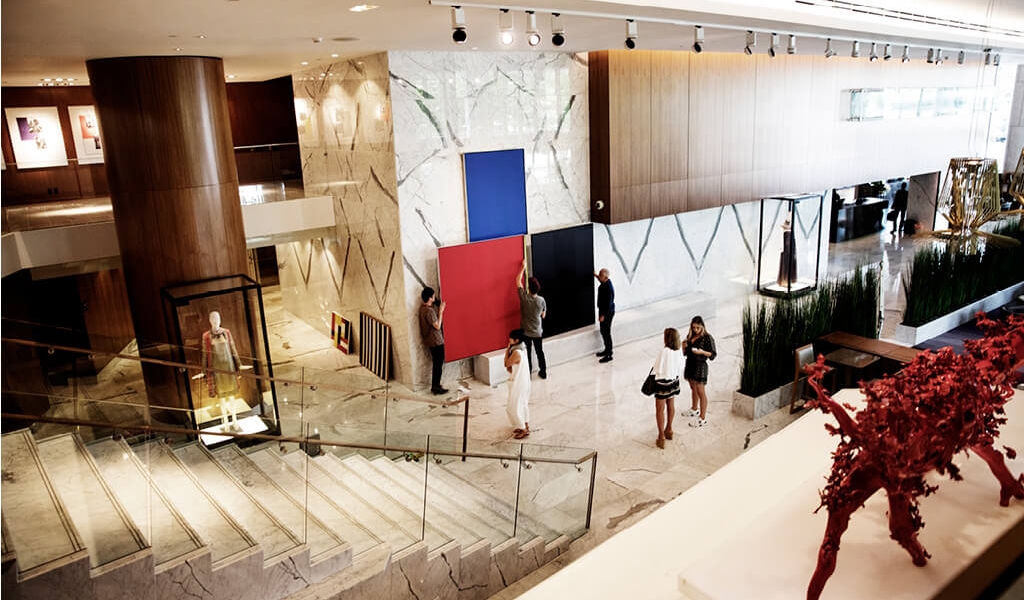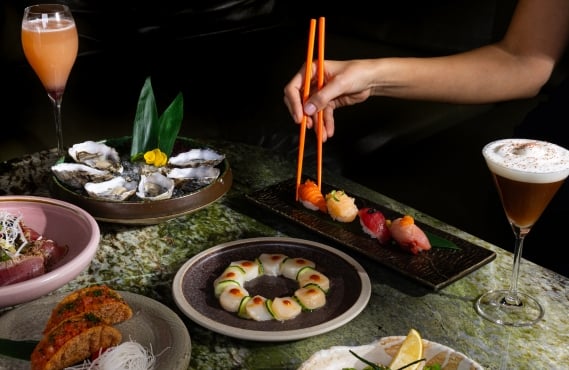Our ever evolving art collection at Fairmont Pacific Rim, which is driven by the interest and passion of our owner and developer, Westbank, has once again expanded with an impressive collection from artist Guido Molinari. This growing series of paintings takes pride of place in our lobby and warmly greets guests as they arrive, all while commanding the attention of those enjoying the live music in The Lobby Lounge and RawBar.
Molinari was born in Montreal, Quebec in 1932 to Italian heritage. His father was one of the founding members of the Montreal Symphony, proving the arts were in his genes. He began painting at age 13, and his existentialist approach to art was formed during a bout with tuberculosis at age 16. He studied at the École des Beaux-Arts de Montréal and the Montreal Museum of Fine Arts.
Guido Molinari practiced abstraction in New York, then returned to Montreal where he produced some of the finest pieces of his career. Works by Molinari, along with those of Ulysse Comtois, represented Canada at the 1968 Venice Biennale. He won a Guggenheim Fellowship in 1967, was made an Officer of the Order of Canada in 1971, and won the Prix Paul-Émile-Borduas in 1980. He was also a member of the Royal Canadian Academy of Arts.
His work is known for its focus on modular and contrasting colours, shapes, and lines. It is exhibited worldwide, including the National Gallery of Canada, the Musée d’art contemporain de Montréal, the Guggenheim Museum and Museum of Modern Art in New York.
One of the most iconic works of art in Fairmont Pacific Rim is the Sérielle bi-bleu. Installed days before ringing in the year 2016, this painting displays a series of carefully executed bands of colour which produce a subtle optical illusion, causing the flat canvas to appear to move in accordion-like folds across one’s field of vision.
The organization of the bi-structure band painting is one set of nine colours repeated twice, making up 18 bands. The left sequence of nine is differently arranged than the same coloured nine bands on the right side of the painting. Each side is made up of 3-threes making up the nine bands. The middle colour of each set of three is the same on each side, but the two colours surrounding alternate. For example, in the first trio of bands, you will find orange, green and ochre. On the right side, the first trio displays ochre, green, and orange. The pattern follows.
The most recent piece to be installed at Fairmont Pacific Rim this July is the Black and White Structure. When Molinari began painting in 1951, he started with automatist paintings, full of gesture and action. By the early 1960’s he started to dwell on vertical structures.
The Bands, or vertical stripes, are one of the most respected and sought-after periods of Molinari. The bands are always equally divided with some sort of colour play going on. Many paintings are split into two sides.
By the early 1980’s the Quantifiers series took hold and occupied Molinari’s work for 15 years. They are always monochromatic or variations of one colour and the paintings glow and seek out observation. These are two exceptional works that have recently been installed in our Lobby.
With his abstract paintings, Molinari favoured geometry and pure colour, and this orientation became central to his art. The Quantificateurs, painted from 1975 to 1997, in blue, deep brown (almost black) and red, are the most extensively considered body of work in his oeuvre.
Molinari’s paintings are always acrylic paint on canvas, normally applied by a roller, with discrete colours in distinct areas defined by masking tape. With the Quantificateurs, Molinari creates something new by adjusting the volume of colour, the choice of colour, the intensity of colour and the placement of colour. Each painting is a communiqué on the quality and quantity of one colour from Molinari to viewers.
Quantificateur bleu is a vertical blue rectangle with a slight sheen picking up the texture of the canvas. There is no sign of the artist’s touch; the work resembles that of vinyl film. The title is equally neutral; It is one of many blue Quantificateurs, distinguished because it was painted in August of 1994 and by its six elongated, irregularly shaped vertical trapezoids. There is no suggestion of its content or meaning embedded in its work. It is one colour, infuriatingly mute.














